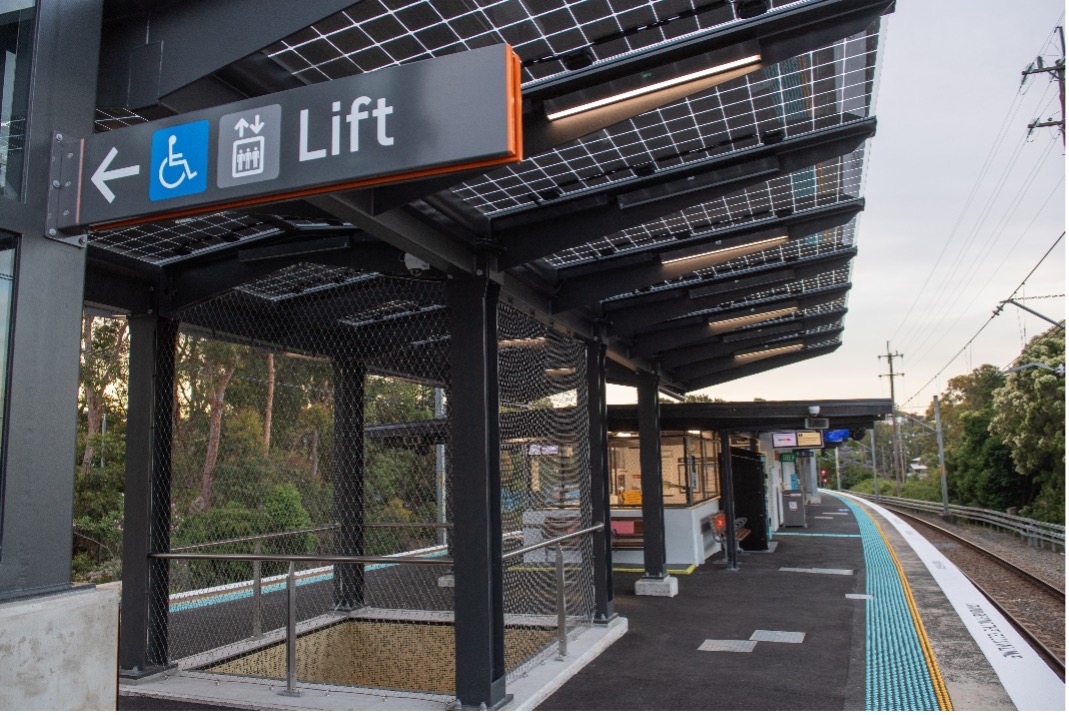Archives: Projects
Rookwood Weir Alliance
Description:
Rookwood Weir is a $367 million water infrastructure investment to drive new economic and employment opportunities for the agricultural industry and the community of Central Queensland.
It is a mass concrete structure with fixed crest spillway, stilling basin, left and right abutments, low flow outlet, and dedicated fish and turtle passage solutions. Situated on the Fitzroy River, 66km south-west of Rockhampton, the completed weir will rise 16.2m above the riverbed and have a full supply volume of 74,325 megalitres.
Rating Highlights
| Category | Credits | Achievements/Risks |
| Energy | Ene-1:
Energy and carbon monitoring and reduction |
Achieved Level 1.5 and 4.17 points:
300,000m2 of excavation volumes was saved by optimising the weir crest length and batter slope design, and 4,427 tonnes of cement have been saved through the Project achieving 63% SCM against a base case of 50% for structural concrete. |
| Water | Wat-2:
Replace potable water |
Achieved Level 2.89 and 3.35 points:
237,000kL (96.5%) of potable water was saved during the design and construction phases by using non-potable from the Fitzroy River. |
| Ecology | Eco-2:
Habitat connectivity |
There were a couple of notable initiatives for the Eco-2 Habitat connectivity credit, which also resulted in the project achieving firsts within the Innovation category.
The construction of an innovative fish lock with multiple entry and exit levels will allow for increased fish passage as head- and tail-waters fluctuate on the Fitzroy River. This innovation achieved State First. A dedicated turtle passage has been specifically incorporated into the design to cater for the movement patterns of the Fitzroy River Turtle and White-throated Snapping Turtle, allowing them safe navigation of the waterway barrier. This innovation achieved Australian First. |
| Innovation | Innovation: Fish Passage | |
| Innovation | Innovation: Turtle Passage |
Verified Innovations
| Name | Verification Date | Innovation Type | Description / Sustainability Benefits | |
| Fish Passage | 24/10/2022 | State First – Innovative Technology or Process | As above | |
| Turtle Passage | 24/10/2022 | Australian First – Innovative Technology or Process | As above | |
| IC-8 Sustainable Suppliers and iSupply | 24/10/2022 | IC-8 Sustainable Suppliers and iSupply | ||
| IC-1 Piloting v2.0/v2.1 credits | 24/10/2022 | Improving on Benchmarks | Leg-1 |
Certification Date:
| 2-May-24 |
TfNSW Wahroonga, Narara and Lisarow Station Access Upgrades (TAP3)
Description:
The Transport Access Program (TAP) is a NSW Government initiative delivering safe, modern and accessible public transport infrastructure across the state, improving access to public transport for people with disability or limited mobility, and parents and carers with prams. This particular TAP 3 project scope includes the Wahroonga, Lisarow, and Narara train station upgrades. The Project constitutes a single submission/rating, encompassing multiple sites (3).
Rating Highlights
| Category | Credits | Achievements/Risks |
| Energy and Carbon | Ene-1 | The project achieved a verified Level 3 with a score of 12.75 points for a 53% reduction in energy use |
| People and Place | Urb-1 | The project met full credit requirements and achieved a score of 5.67 points for Level 3 |
Verified Innovations
| Name | Verification Date | Innovation Type | Description & Sustainability Benefits | |
| I-Supply | 07/11/23 | | IC-8 | Sustainable products and/ or services were listed in the ISupply directory and were implemented into the project |
| V2.1 Rso-6 & 7 | 07/11/23 | | IC-1 | The trailing of the material credit and calculator of Rating v2.1 |
| Ene-1 | 07/11/23 | Improving on credit benchmarks | Some of the benefits included the use of overhangs, louvres, and natural ventilation to eliminate the need for Active Cooling systems. | |
| Urb-1 | 07/11/23 | Improving on credit benchmarks | Meeting full credit requirements, including the utilisation of a Design Review Panel. |
Certification Date:
| 10-May-24 |
Bruce Highway Upgrade Project – Caboolture to Steve Irwin Way
Description:
The Queensland Government is upgrading 11km of the Bruce Highway between Caboolture and Steve Irwin Way, as part of a $662.5 million project to reduce congestion and improve flood immunity. Split into two separate construction contracts, Acciona Infrastructure Projects Australia (ACCIONA) delivered Contract 1 between Caboolture-Bribie Island Road and Pumicestone Road, with a contract value of $150 million.
Contract 1 involved upgrading the Bruce Highway from four to six lanes, as well as upgrades to creek crossings, improvements to entry and exit ramps at interchanges, and the installation of Smart Motorways technologies to improve safety and manage traffic flow.
The initial IS Design Rating was delivered by Jacobs SMEC Design Joint Venture in 2019-2020. ACCIONA delivered the As Built Rating for Contract 1.
Rating Highlights
| Category | Credits | Achievements/Risks |
| Climate Change Adaptation | Cli-2 | Achieved Level 3 and 3.52 points
The project demonstrated exceptional performance in the assessment and implementation of climate change adaptation measures. |
| Energy | Ene-1 | Achieved Level 2.15 and 6.81 points
17% reduction in fuel and electricity consumption through value engineering reductions in haulage, construction lighting supplemented by renewables, and an upgrade from HPS to LED street lighting. |
| Water | Wat-1 | Achieved Level 2.73 and 4.33 points
17.3% reduction in water use for various construction works. |
| Wat-2 | Achieved Level 2.96 and 2.61 points
98% replacement of potable water with non-potable water. Almost all non-potable water was sourced from local sources, site compound roofs, ponding water on-site and sediment basins. |
|
| Materials | Mat-1 | Achieved Level 2.69 and 5.68 points
25% reduction in lifecycle emissions through the use of EME2 for an extended design life for the road pavement, 15% recycled asphalt pavement content (RAP) in some asphalt mixes, 30-44% cement replacement in concrete mixes off a base case of 20%. |
Verified Innovations
| Name | Verification Date | Innovation Type | Description & Sustainability Benefits | |
| Invertebrate-Sensitive Road | 04/12/2023 | | Australian First
(Piggyback) |
The project was one of the first in Australia to incorporate an invertebrate-sensitive road design for the Richmond Birdwing Butterfly into their design.
The project recognised that road assets across Australia typically focus on implementing fauna sensitive designs, but there was a distinct lack of consideration for invertebrates, particularly for a species that is classed as ‘vulnerable’. Just south of the Lagoon Creek site, the following flora species were planted to connect and increase the Richmond Birdwing Butterfly’s habitat between the Sunshine Coast and Greater Brisbane:
|
| GuardDog Drain Filter | 04/12/2023 | | Australian First
(Piggyback) |
The project was one of the first in Australia to implement the use of the GuardDog Drain Filter.
The innovative product has many sustainability benefits:
|
| IC-8 Sustainable Suppliers and iSupply | 04/12/2023 | | IC-8 Sustainable Suppliers and iSupply | Used at least three products or services currently listed on the iSupply directory |
| IC-1 Piloting new category or credits (v2.0 Sta-1) | 04/12/2023 | | IC-1 Piloting new category or credits | – |
| IC-1 Piloting new category or credits (v2.0 Gre-1) | 04/12/2023 | | IC-1 Piloting new category or credits | – |
| IC-1 Piloting new category or credits (v2.1 Leg) | 04/12/2023 | | IC-1 Piloting new category or credits | – |
Certification Date:
| 2-May-24 |
Pound Road West and Frankston Dandenong Bridge Upgrade Project
Description:
The project comprises the following key scope items:
• Construction of a new four lane bridge over the Cranbourne rail corridor to connect Pound Road West and Remington Drive.
• Upgrades to Pound Road West and Remington Drive from one lane to two lanes in both directions to improve through traffic capacity.
• Shared walking and cycling paths on both sides of the road along the project length.
• Upgrade to existing intersections at Abbotts Road and South Gippsland Highway to improve capacity.
• Installation of new traffic signals at the intersections of Remington Drive and Ventura Place, and Remington Driveand Hydrive Close
• Installation of new street lighting, road signage and landscaping along the project length
• Installation of new drainage and utility service upgrades/relocations
Rating Highlights
| Category | Credits | Achievements/Risks |
| Materials | Mat-1 | The Project achieved a verified level of 3 with a score of 5.41.
The Project achieved a 33% reduction in IS EnviroPoints and 34% reduction in GHG emissions compared to the base case (25,541.62 tCO2-e to 16,891.06 tCO2-e). Material reduction initiatives implemented during construction include:
|
| Waste | Was-2 | The Project achieved a verified level of 3 with a score of 3.16.
The Project successfully managed to divert 91% of all inert and non-hazardous waste from landfill. Additionally, more than 43,000 m3 of clean fill material from the project has been used to fill and rehabilitate farm paddocks and landscaping golf course. |
| Stakeholder Participation | Sta-2 | The Project achieved a verified level of 3 with a score of 1.69.
The Project has collaborated with stakeholders on negotiable issues such as the removal of street parking during construction and the reuse of a memorial tree. The Project has worked closely with a business to reduce the possibility of a financial loss due to the removal of street parking. The Project also remained in contact with the affected family of the memorial tree to ensure a suitable replacement could be installed. |
Verified Innovations
| Name | Verification Date | Innovation Type | Description & Sustainability Benefits | |
| MST Bar | 21/12/23 | | Innovative Technology or Process
Australian First |
The Project received 3 points for this innovation.
The Project utilised an MST Bar (a glass fibre reinforced polymer rebar) in the post and panel retaining wall in place of steel reinforcement bars. Compared to the use of a steel rebar, this innovation contributed to the following sustainability benefits:
|
| Recovered Carbon Black (rCB) | 21/12/23 | Innovative Technology or Process
State First |
The Project received 1 point for this innovation.
Recovered Carbon Black was incorporated into the asphalt on the project. This material is derived from waste tyres and replaced fine ground limestone in the previously approved asphalt mix design. The Project’s use of this innovative material increased the demand for recycling tyres, reduced the use of a carbon intensive and finite resource, and provided an expansion opportunity for the supplier (Entyr). |
Certification Date:
| 2-May-24 |
Sydney Metro City & SW – Line-wide Works
Description:
The Sydney Metro City & Southwest (SMCSW) project will extend Sydney Metro Northwest to the CBD through Chatswood and beyond to Bankstown. The project is being delivered through a suite of contracts for the tunnels, stations, line-wide infrastructure and systems. The Line-wide Works (LW Works) package is a key component of SMCSW with works taking place over the full length of the Project area.
- The fit out of the Sydney Metro City & Southwest tunnels and stations including provision of track, overhead wiring, HV reticulation, tunnel ventilation, fire services tunnel services
- Delivery of bulk power feeds to meet the Sydney Metro City & Southwest high voltage reticulation and traction power requirements
- Expansion of the Sydney Metro Trains Facility at Tallawong
- The delivery of a new train stabling and infrastructure maintenance facility at Sydenham (Marrickville)
- The open northern dive works to tie Sydney Metro City & Southwest into the Sydney Metro Northwest at Chatswood
- Provision of HV reticulation and traction power for the Southwest corridor from Sydenham to Bankstown
Rating Highlights
| Category | Credits | Achievements/Risks |
| Energy and Carbon | Ene-1 | The Project achieved a verified level of 3 with a score of 14.46.
The Project have projected a 99.8% energy use reduction across construction and operation compared to the base case (19,279,233 tCO2-e to 46,717 tCO2-e). The following initiatives were implemented to reduce energy use:
|
| Water | Wat-1 | The Project achieved a verified level of 3 with a score of 7.23.
The Project forecasted a 74.7% reduction in water use across construction and operation compared to the base case (1,610.5ML to 1,202.7ML). Examples of the water reduction initiatives implemented include:
|
| Materials | Mat-1 | The Project achieved a verified level of 1.97 with a score of 4.22.
The Project achieved a 15% reduction in IS EnviroPoints compared to the base case. The material reductions were achieved through:
|
Verified Innovations
| Name | Verification Date | Innovation Type | Description & Sustainability Benefits | |
| Improving on Credit Benchmarks (Ene-1, Ene-2, Wat-1) | 6/10/23 | | Improving on Credit Benchmarks | The Project received 3 points for exceeding the Level 3 benchmarks for Ene-1, Ene-2 and Wat-1. |
| Regenerative Energy Recovery (Thyristor Inventor) | 6/10/23 | | Innovative Technology or Process
Australian First |
The Project received 3 points for this innovation.
The Project demonstrated the first use of Thyristor Invertor technology for regenerative energy recovery system on a high voltage network (1500 V DC). This innovation has several sustainability benefits which includes:
|
| Geopolymer Sleeper Trial | 6/10/23 | | Innovative Technology or Process
Australian First |
The Project received 3 points for this innovation.
The Project conducted a trial use of 52 Geopolymer sleepers at the SMTF South depot at Marrickville. The Geopolymer concrete is a low-carbon concrete made from 100% supplementary cementitious materials as the replacement binder (instead of typical Portland cement sleepers). The sustainability benefits include:
|
| Recycled Crushed Glass | 6/10/23 | | Innovative Technology or Process
State First |
The Project received 1 point for this innovation.
The Project utilised recycled crushed glass as bedding material at SMTF North site instead of natural sand. This innovation has several benefits including:
|
Certificatiion Date:
| 10-May-24 |
Niagara Park, Ourimbah, Beecroft TAP3 Projects
Description:
The upgrade works (the Project) were completed for the Niagara Park, Ourimbah and Beecroft stations as part of the Transport Access Program (TAP), an NSW Government initiative delivering safe, modern and accessible public transport infrastructure across the state. Providing accessible transport services for everyone in the community is one of the six priorities for Transport for NSW’s Future Transport Strategy. The third tranche of the Transport Access Program, known as TAP 3, seeks to improve access to public transport for those with a disability, limited mobility, and parents and carers with prams.
Rating Highlights
| Category | Credits | Achievements/Risks |
| Energy and Carbon | Ene-1 | The Project achieved a verified level of 2.13 with a score of 9.71.
Carbon and energy initiatives implemented on the project are predicted to result in an estimated greenhouse gas emissions saving of about 1,420 t CO2. |
| Water | Wat-1 | The Project achieved a verified level of 2.94 with a score of 4.47.
An overall water use reduction of 19% (compared to the base case) is expected from construction and operations (50 years). |
Verified Innovations
| Name | Verification Date | Innovation Type | Description & Sustainability Benefits | |
| Urb-1 Utilising an Independent Design Review Panel | 23/03/23 | | Improving on Credit Benchmarks (Inn-1.10 Innovation Ruling) | The Project received 1 point for meeting full credit requirements. |
| Was-3 Deconstruction Plan | 23/03/23 | | Improving on Credit Benchmarks (Inn-1.10 Innovation Ruling) | The Project received 1 point for integrating deconstruction and decommissioning as core element of design. |
Certification Date:
| 8-May-24 |
TAP 3- Erskineville, St Peters, Normanhurst, Thornleigh, Pymble, Doonside Stations Upgrade
Description
The Transport for New South Wales (TfNSW) Transport Access Program (TAP) is an initiative to provide a better experience for public transport customers by delivering accessible, modern, secure and integrated transport infrastructure.
This project consists of six station upgrades which are delivered under Laing O’Rourke’s Managing Contractor Contract. The six stations are referred to as PENTSD and they are: Pymble, Erskineville, Normanhurst, Thornleigh, St Peters, and Doonside.
Rating Highlights
| Category | Credits | Achievements/Risks |
| Energy and Carbon | Ene-1 | The Project achieved a verified level of 3 with a score of 15.57.
The Project achieved a 38% reduction in lifecycle GHG emissions compared to the based case (2,591 tCO2-e to 1,618 tCO2-e). |
| Water | Wat-1 | The Project achieved a verified level of 3.
The Project achieved a 31% water use predicted reduction compared to the base case (145.9 ML to 100.1 ML). |
| Materials | Rso-7 | The Project achieved a verified level of 3.
The Project achieved 10% material spend on approved sustainability labelled products compared to the total project capital value ($11,862,329 out of approx. $101m). |
Verified Innovations
| Name | Verification Date | Innovation Type | Description & Sustainability Benefits | |
| Piloting updated credit: Rso-6 and Rso-7 | 05/10/2023 | | Innovation Challenge (IC-1) | The Project received 0.15 points for trailing v2.0 Rso-6 and Rso-7 instead of v1.2 Mat-1 and Mat-2 credits. |
Certification Date:
| 10-May-24 |
Princes Highway East Duplication – Kilmany Section
Description:
The Princes Highway East Duplication – Kilmany Section (PHEK) is approximately 5.1km long and extends from east of Maffra-Rosedale Road Nambrok, to Velore Road, Kilmany.
Rating Highlights
| Category | Credits | Achievements/Risks |
| Materials | Mat-1 | The Project achieved a verified level of 3 with a score of 8.13.
The Project demonstrated a total materials emission reduction of 38% compared to the base case (17,033 tCO2-e to 10,541 tCO2-e). Key contributions to the emission reductions include reduced material quantities, use of 30% SCM for reduced volume of in-situ concrete, optimisation of the bridge superstructure design and consolidation of drainage lines. |
| Discharges to Air, Land and Water | Dis-4 | The Project achieved a verified level of 3 with a score of 3.22.
The Project conducted an Air Quality Assessment as part of the Environmental Effects Statement and reported medium to high dust generation from construction and minor operational impacts to air quality. To mitigate and monitor the dust impacts, the Project adopted continuous monitoring devices, visual screens, and dust suppressants. |
| Water | Wat-2 | The Project achieved a verified level of 2.98 with a score of 3.36.
The Project’s monitoring and modelling suggests a 99.45% reduction in potable water use. This will be achieved by the installation of two 10,000L rainwater tanks and two water meters (one for potable and one for non-potable water). These initiatives will allow construction and operational (site office toilets) water use to largely come from non-potable sources. |
Certification Date:
| 8-May-24 |
TAP3 Waitara Station
Description:
The upgrade works (the Project) were completed for Waitara Station as part of the Transport Access Program, an NSW Government initiative delivering safe, modern and accessible public transport infrastructure across the state. Providing accessible transport services for everyone in the community is one of the six priorities for Transport for NSW’s Future Transport Strategy. The third tranche of the Transport Access Program seeks to improve access to public transport for those with a disability, or limited mobility, and parents and carers with prams.
Upgrading this station will make it easier for all customers to access, as well as improve connections between the station and key destinations in the area.
The project involves the installation of:
- a new pedestrian underpass.
- a new station entrance.
- two new elevator lifts.
- a new platform canopy.
- a redesigned platform including resurfacing and the installation of two new boarding assistance zones.
- new family accessible and ambulant toilets.
- bike racks.
- CCTV
- lighting upgrades and
- a new adjacent station car park.
Rating Highlights
| Category | Credits | Achievements/Risks |
| Climate Change Adaptation | Cli-2 | The Project achieved a verified level of 3.
The Project’s climate change risk assessments identified five high climate change risks related to extreme heat, rainfall, flooding, high winds, and bushfires. |
| Waste | Was-3 | The Project achieved a verified level of 3.
The Project estimates that 87.2% of recoverable materials ($2,762,389 out of $3,167,827 total material cost) will be available for deconstruction with a majority of this value component ($2,575,650) consisting of steel and concrete. This was achieved through integrating appropriate material selection into design considerations. |
Verified Innovations
| Name | Verification Date | Innovation Type | Description & Sustainability Benefits | |
| Was-3 | 04/03/24 | | Improving on Credit Benchmarks – SPP | The Project received 1 point for meeting full credit requirements. |
| Urb-1 | 04/03/24 | Improving on Credit Benchmarks – SPP | The Project received 1 point for meeting full credit requirements. |
Certification Date:
| 10-May-24 |
Transport Access Program Denistone and Stanmore Station Upgrades
Description:
The Transport Access Program (TAP) is an initiative by the NSW Government, dedicated to enhancing the accessibility and convenience of public transport infrastructure across the state. For this project the Denistone and Stanmore railway station scopes are centred around improving public transport access for individuals with disabilities, limited mobility, and parents or carers with prams.
Rating Highlights
| Category | Credits | Achievements/Risks | ||||||||
| Climate Change Adaptation | Cli-2 | The Project achieved a verified level of 3 with a score of 2.89.
The Project identified one high priority risk related to extreme rainfall causing flooding and blockages to drainage systems and culverts. Subsequently, a proposed drainage system design was implemented resulting in a medium residual risk rating. Other mitigation measures implemented to reduce extreme heat related risks include:
|
||||||||
| Community Health, Well-being and Safety | Hea-1 | The Project achieved a verified level of 3 with a score of 2.89.
The Project identified three community priority issues to positively contribute to:
|
Verified Innovations
| Name | Verification Date | Innovation Type | Description & Sustainability Benefits | |
| ISupply | 6/10/23 | | Innovation Challenge (IC-8) | The Project received 0.75 points for using the following services/products from the ISupply Directory:
|
Certification Date:
| 8-May-24 |
Transport Access Program 3 – Como Station
The Como Station Upgrade Project (the Project) is part of the third tranche of Transport for NSW’s (TfNSW) Transport Access Program, known as TAP 3 and seeks to improve access to public transport for people with disability or limited mobility, parents and careers with prams, and customers with luggage. Providing accessible transport services for everyone in the community is one of the six priorities from TfNSW’s Future Transport Strategy.
Upgrading train stations will provide fair and equitable access for all customers, as well as improving connections between the station and key destinations in the area. Works at Como Station include:
- Construction of a new lift between the station platforms and underpass including associated lobbies and awnings.
- Removal of the existing ramp from Como Parade to the underpass with the construction of a new lift and access stairs from the street level and carpark to provide access to the existing underpass.
- Implementation of a Solar Photovoltaic (PV) Glass canopy on the platform.
- Removal of the existing ramp on Railway Road and the construction of new DDA compliant ramp from the street to the underpass.
- Formalisation of the kiss and ride area on Railway Road with nosing and handrail upgrades to the existing access stairs.
- Regrading and relocation of three accessible spaces in the Como Parade commuter carpark. .
- New accessible pathways throughout the station precinct including the resurfacing of platforms and platform coping tactile upgrades.
- Upgrading of the existing toilets to accommodate one unisex family accessible toilet and ambulant male and female toilets.
- A station power supply upgrade including the installation of new padmount transformer and LV/HV pole adjustments including all associated containment and cabling works.
- New compliant drainage throughout the station precinct.
- Upgrading of the CCTV, Security, AFILS and PA systems.
As Built Rating Highlights
Highlight 1: Climate Change and GHG emissions
Respond to climate change
A comprehensive Climate Change Risk Assessment (CCRA) was undertaken with relevant stakeholders (inc. TfNSW, GHD, Degnan, etc) using TfNSW’s climate risk assessment tools. Mitigation measures have been identified and implemented for 100% of extreme, high, and medium risks identified within the CCRA.
Energy/GHG Reductions
The project design has modelled a 45.7% lifecycle energy and 49.1% lifecycle greenhouse gas emissions reduction over base case, aligning to the TfNSW Sustainability Plan goals and Transport Future Energy Strategy.
This was achieved through the following initiatives:
- Reduction of plant and equipment usage by substituting activities such as concrete piling in favour of rock anchors, removal of shotcrete for natural finishes, and retention of existing retaining walls.
- Efficient Lighting design using LEDs, timers, and Photoelectric cells.
- Efficient HVAC design using Inverter Air Conditioning technologies.
- Renewable energy substitution through Solar PV Glass.
Renewable Energy
Degnan and TfNSW provided considerable effort to research and implement a novel Solar Photovoltaic (PV) Glass canopy manufactured by Onxy Solar instead of a standard canopy design, which will provide the following benefits:
- The provision of up to 58 kWh of renewable energy per day, which is approximately equal to the station’s daily electricity demand.
- The offset of up to 185 tonnes of CO2 emissions within the first 10 years of operation.
- A 29.4% substitution for renewable energy across the asset’s design life.
- Futureproofing for possible electricity export to the grid and storage batteries.
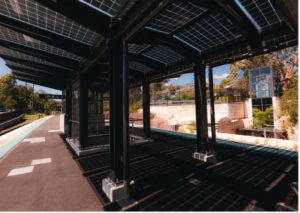
Highlight 2:Improved environmental outcomes
Improve environmental outcomes
The project design has modelled an 18.5% lifecycle water use reduction over base case, supporting the NSW Government’s commitment to resource efficiency.
Materials Impact Reduction
The project design has modelled a 21% material EnviroPoint reduction over base case, supporting the NSW Government’s commitment to resource efficiency.
This was achieved through the following initiatives:
- Reduction of materials by substituting methodologies such as concrete piling in favour of rock anchors, removal of shotcrete for natural finishes, and retention and strengthening of retaining walls in favour complete demolition.
- High SCM replacement within concrete mixed designs, including up to 55% for certain structural and 49.4% non-structural components.
- Substitution of steel reinforcement in favour of E-mesh recycled plastic reinforcement for non-structural components.
- A minimum of 15% RAP in all asphalt mixes.
Highlight 3: Community connection / Respect of culture and heritage
Connecting with communities / Respect culture and heritage
The project has undertaken several community-based initiatives. The three put forward for the Design submission were:
- Vegetation Enhancement: The project proposed to provide 60 trees, 76 shrubs and over 1000 grasses both onsite and within the local area to enhance the vegetation and improve the amenity of the surrounding community.
- Local Disability Employment and Inclusion: The project provided employment and design consultation for local disability groups through onsite catering, construction of recycled timber formwork for platform garden beds, on-site safety walkthroughs, and design discussion workshops. A design update suggested by the St. George and Sutherland Community College was the use of upsized lift call buttons.
- Non-Aboriginal Heritage Promotion: The project team worked with TfNSW to utilise heritage interpretation to improve the customer and community experience. A heritage photograph of the original Como Station was obtained from the local council library and converted into a custom vertical formwork mould by Reckli® to transpose the image onto the station entrance walkway.
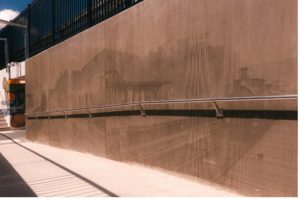
A gate from the original Station Master’s gate house was discovered during construction. The gate was mounted with signage to inform of its original use and its significance in the historical station configuration.
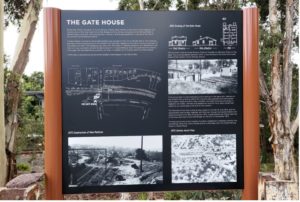
- Aboriginal Involvement in Design: The project has put considerable effort into Aboriginal Community Involvement in urban design. The Kurranulla Aboriginal Corporation was consulted and requested to provide designs and implement 2 artwork murals within the station underpass. The implemented designs reflect the Aboriginal heritage of the lands surrounding the station and significance to the Dharawal People.
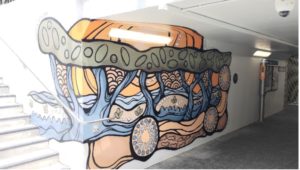
These design inputs were facilitated by TfNSW’s Aboriginal Engagement Team and Kurranulla, who were invited to provide a Welcome to Country and Smoking Ceremony at the official station opening ceremony.
- Improved Urban Design: The project team identified the opportunity for an improved visual experience by utilising the natural environmental aspects within the urban design. The lift shaft excavation exposed natural sandstone features which were polished and showcased instead of the original shotcrete design finish. Further sandstone material complimented the excavation walls to improve the amenity of the station entrance and provide the station with a warm and inviting aesthetic for the community.
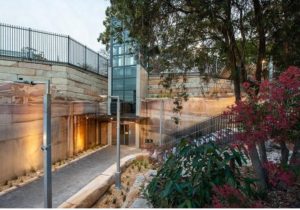

Highlight 4:Innovative Technology
The Solar Photovoltaic Glass initiative discussed above was verified as an Industry 1st, as below:
- Industry 1st for innovative technology or process – The Australasian Railway Association’s (ASA) Rail Infrastructure Contractors Executive Committee and the Sustainability Committee both endorsed the Solar Photovoltaic Glass initiative as the first application of its kind in the Australian rail market.
- Innovation Challenge IC-4 – The project engaged with 3 organisations listed on the ISupply Directory for products and services to be applied to the project
- Exceeding benchmarks for small project pathways – This project has exceeded the small projects pathway through completion of the full credit requirements. Man – 6, Hea – 1 and Urb – 1
Verified Innovations
| Name | Verification Date | Innovation Type | Description & Sustainability Benefits |
| IC-5 High Clinker Substitution | 30/10/23 | Innovation Challenge (IC-5) | The Project received 1.27 points for achieving an average substitution rate of 53.52% across all concrete mixes. |
| Man-6, Hea-1, and Urb-1 ECB
|
30/10/23 | Exceeding Credit Benchmark (Small Project Pathway) | The Project received 3 points for exceeding credit benchmarks by completing full credit requirements for Man-6, Hea-1, and Urb-1. |
| ISupply | 30/10/23 | Innovation Challenge (IC-8) | The Project received 0.75 points for using the following services or products from the ISupply directory:
|
| Solar Photovoltaic Glass | 20/09/2022 | Innovative Technology or Process
State First |
The Project received 1 point for this innovation.
The Project has achieved a State First for the rail industry by installing solar PV glass within the rail corridor. An educational piece regarding solar glass was also added on the public website for the Como Station Upgrade. For this innovation, the Project have also received the Banksia Foundation NSW Sustainability Awards in Clean Technology category in December 2021. |
| Ene-1 ECB
|
30/10/23 | Exceeding Credit Benchmark | The Project received 1 point for exceeding the gap between Level 2 (15%) and Level 3 (30%) benchmarks for emissions reduction. |
Acknowledgements
The Project acknowledges
- Transport for NSW
- Degnan Constructions
- GHD
- Design Inc.
- Sutherland Shire Council
- The Kurranulla Aboriginal Corporation and in particular Deanna Schreiber and Merindah Funnell
- The St George & Sutherland Community College (SGSCC) disAbility team
Testimonial
“I am thrilled to commend the extraordinary achievements in sustainability outcomes that the Como Station Upgrade Project has realised. From the project’s inception, the entire team’s unwavering commitment to integrating responsible sustainability practices has yielded remarkable results. Our strategic implementation of energy generation technologies, community engagement initiatives, and comprehensive waste management strategies has not only met but surpassed many of our sustainability objectives. The successful reduction of our carbon footprint, positive contributions to local communities, and the establishment of a benchmark for non-listed heritage interpretation exemplifies our dedication to leaving a lasting, positive impact. This Project has not only elevated our corporate reputation but has set a standard for sustainable project management practices within our organisation, a testament to the collective effort and dedication of our exceptional team.”
– Josh Petre – Head of Engineering, Assurance & Sustainability Degnan Constructions
Certification Date:
| 10-May-24 |

